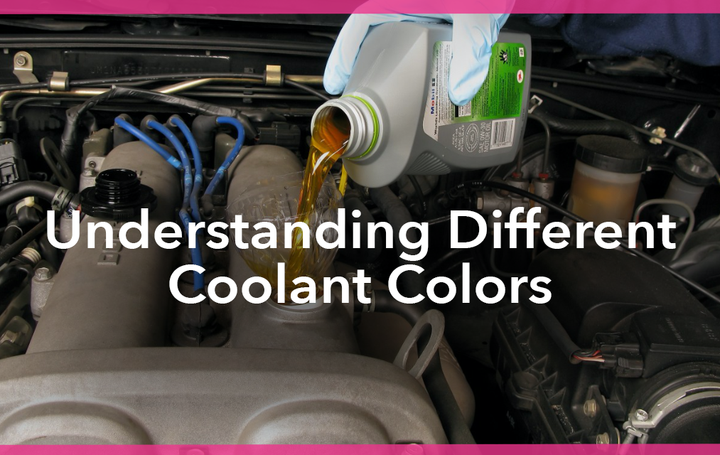


Coolant colors have evolved from mere indicators of additive technologies to powerful branding and marketing tools. While the color itself may not directly reveal the coolant's chemistry or composition, understanding the significance of proper coolant selection, compatibility, and maintenance is crucial for ensuring the longevity and optimal performance of your vehicle's cooling system.
Coolants come in a vibrant spectrum of colors, from greens and yellows to oranges, reds, blues, and pinks. However, the color alone does not necessarily indicate the type or chemical composition of the coolant. This guide explores the fascinating world of coolant colors, delving into their historical significance, chemistry, branding strategies, compatibility considerations, environmental impact, and industry regulations.
In the past, coolant colors were more indicative of the additive technology used. The table below illustrates the common color associations with early coolant technologies:
| Coolant Color | Additive Technology |
|---|---|
| Green/Blue | Inorganic Additive Technology (IAT) for older vehicles |
| Orange | Organic Acid Technology (OAT) for longer service life |
| Yellow/Orange | Hybrid Organic Acid Technology (HOAT), combining IAT and OAT |
Over time, manufacturers shifted away from using color as an indicator of additive technology, embracing it as a branding and marketing tool instead.
Coolants are formulated with various components to enhance performance and functionality. The table below outlines common coolant types and their compositions:
| Coolant Type | Composition |
|---|---|
| Inorganic Additive Technology (IAT) | Inorganic salts and silicates as corrosion inhibitors |
| Organic Acid Technology (OAT) | Organic acids like sebacates and benzoates as corrosion inhibitors |
| Hybrid Organic Acid Technology (HOAT) | Combination of inorganic and organic additive technologies |
| Silicate-based | Silicate compounds as corrosion inhibitors |
| Phosphate-based | Phosphate compounds as corrosion inhibitors |
Additionally, coolants may contain various additives, such as corrosion inhibitors, antifoam agents, biocides, and dyes or colorants.
Manufacturers leverage color psychology and consumer perceptions to create brand recognition and differentiate their products. They may experiment with:
Vibrant and unique color choices
Color-changing coolants
Optical brighteners and special effects
These strategies aim to capture consumer attention and appeal to personal preferences.
Proper coolant selection is crucial to avoid chemical reactions, deposits, and potential damage to the cooling system. It is essential to:
Follow the vehicle manufacturer's recommendations
Consult the owner's manual or a professional mechanic
Use the same product or a compatible universal coolant when topping up
Regular coolant maintenance, including flushing and system cleaning, is also vital for optimal cooling efficiency.
While coolants are designed for safe use, they can pose health hazards if ingested or exposed to the skin or eyes. Proper handling, safety precautions, and disposal methods must be followed to prevent environmental contamination and comply with regulations.
Some manufacturers offer biodegradable coolant formulations or participate in coolant recycling programs to promote sustainability and reduce environmental impact.
The automotive industry has established standards and certifications for coolants, covering aspects such as color coding, chemical composition, and performance requirements. Manufacturers must comply with these standards and relevant regulations regarding product labeling and information disclosure.
By considering factors such as environmental impact, safety considerations, and industry regulations, consumers can make informed decisions when choosing and using coolants. Prioritizing the recommended coolant type and following manufacturer guidelines will help maintain a healthy and efficient cooling system, regardless of the coolant's vibrant hue.
The color of coolant does not directly indicate its chemical composition or type. It is primarily used for branding and marketing purposes by manufacturers.
Historically, green/blue coolants contained inorganic additive technology (IAT), orange coolants used organic acid technology (OAT), and yellow/orange coolants were hybrid organic acid technology (HOAT).
Inorganic Additive Technology (IAT) coolants contain inorganic salts and silicates as corrosion inhibitors. Organic Acid Technology (OAT) coolants use organic acids like sebacates and benzoates. Hybrid Organic Acid Technology (HOAT) combines inorganic and organic additives.
Manufacturers leverage color psychology, unique color choices, color-changing coolants, and optical brighteners to create brand recognition, differentiate products, and appeal to consumer preferences.
Proper coolant compatibility is crucial to avoid chemical reactions, deposits, and potential damage to the cooling system. It is essential to follow the vehicle manufacturer's recommendations and use compatible coolants.
Some coolants can pose health hazards and environmental contamination risks if not handled or disposed of properly. Manufacturers offer biodegradable formulations and recycling programs to promote sustainability.
Coolants can be hazardous if ingested or exposed to the skin or eyes. Proper handling, safety precautions, and disposal methods must be followed to prevent health risks.
The automotive industry has established standards and certifications for coolants, covering aspects such as color coding, chemical composition, and performance requirements. Manufacturers must comply with these standards and relevant regulations.
Regular coolant maintenance, including flushing and system cleaning, is vital for optimal cooling efficiency and preventing issues caused by contamination or degradation of the coolant.
Consumers can make informed decisions by considering factors such as environmental impact, safety considerations, industry regulations, and following the vehicle manufacturer's recommendations for the appropriate coolant type and maintenance schedule.

Miguel started tinkering with car radios as a teenager, fascinated by the intricate dance of wires and circuits. This passion led him to pursue a career as an automotive electrician. For the past 10 years, Miguel has tackled everything from flickering headlights to mysterious electrical gremlins. He thrives on troubleshooting electrical problems and enjoys sharing his knowledge to empower car owners to understand their vehicles better.





